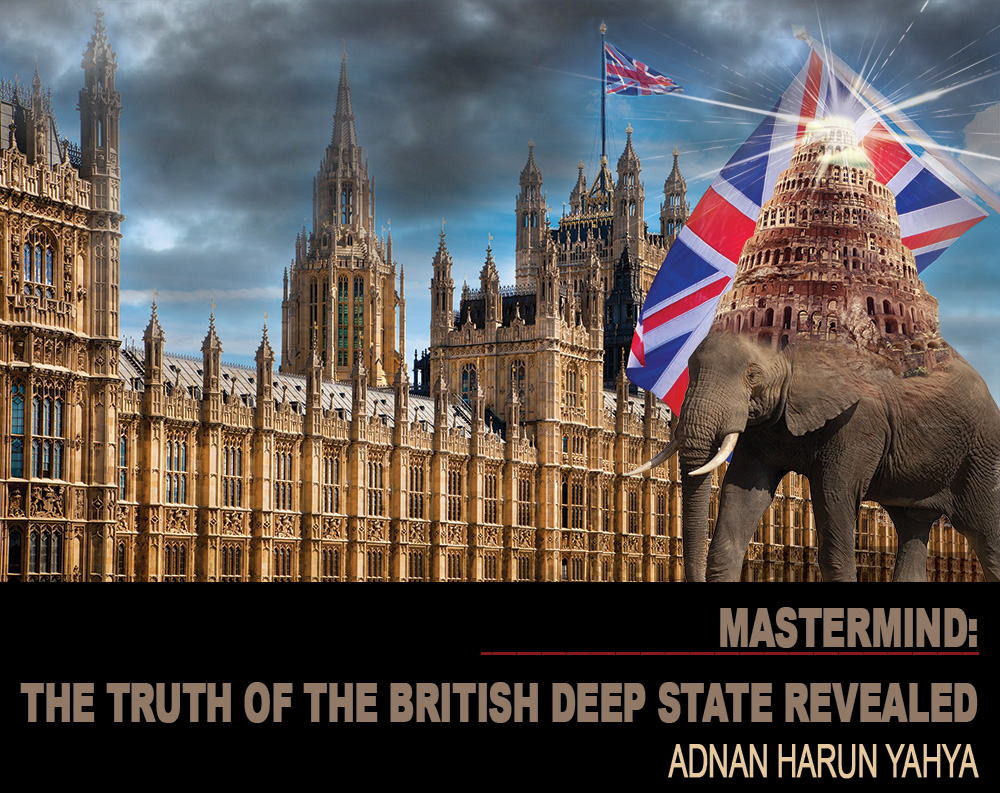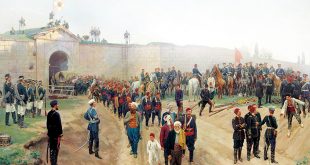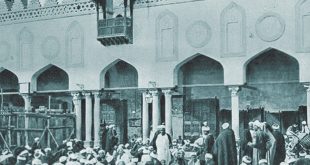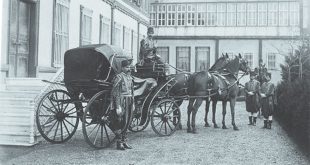 |
| A French magazine that closely followed all the military coups that took place in the Ottoman Empire. The source of the coup-related news in Europe was always the British deep state.4. Military Coups and Territorial Losses |
Many of the military coups that took place in the past 200 years bear the hidden marks of British deep state intervention. This dark structure changes administrations by means of coups, which it considers a quick, cheap and covert way to further its policies.
Coup plotters are arrogant and usually impressionable people who are not held to account for their actions. They fall for the games of the British deep state for their personal petty gains. They never deserve the positions they gain through coups, as it is only violence and guns and definitely not their knowledge, talents, expertise or experience that brings them to such positions. As such administrations are only transitional regimes, the true names behind the decisions made during those times remain usually unknown and the corruption and problems are usually blamed on a few. This way, the true perpetrators, most notably the British deep state, are kept away from public eyes.
This was the case with the Ottoman Empire too. When her fall began, she was in possession of an impressive 500-year-old experience in running an empire. She had powerful, well-functioning systems in the military, the economy, and education, among other aspects of life. For this reason, the British deep state was in need of a transitional regime because that was the only way to control this powerful Empire. Such intermediate regimes, laden with corruption and misconducts with no visible culprit, gave these elusive powers the opportunity they needed to bring the Empire closer to destruction. For this reason, it is important to carefully analyze the driving power behind the coups in the Ottoman Empire: the British deep state, just as in many other coups around the world.
The Origin of All Coups: The Coup of 1876
 |
| Hüseyin Avni Pasha |
The first modern coup in Turkish history is usually considered the one that saw the deposition of Sultan Abdülaziz in 1876. The coup plotters, i.e., Midhat Pasha (head of the Committee of the New Ottomans), Hüseyin Avni Pasha (Chief of Staff), and Süleyman Pasha (Minister of War), deposed the Sultan and brought Murat V to power instead. As would be the case throughout the Republican period, military students were used for the coup. Ten days later, Sultan Abdülaziz was martyred, which was clumsily made to look like a suicide.
As the British deep state spread the lie that the Ottoman Empire was losing its influence and became a ‘sick man’, the Empire was in truth enjoying one of its powerful eras under the leadership of Sultan Abdülaziz.
In 1876, the Ottoman Empire was the world’s most powerful fourth state; it had the world’s fourth biggest army and the third biggest fleet. In 1876, it encompassed a territory of 12 million sq. km with a total population of 64 million people. The 1876 territory of the Ottoman Empire included what are today 35 different countries. During those days, Istanbul was the world’s fifth biggest city.
Sultan Abdülaziz was a brave sultan that took a clear stance against the British deep state. He didn’t allow the spread of Darwinism, and removed the British deep state spies from his immediate circle. He removed Hüseyin Avni Pasha from his duties for being a Darwinist and for his pro-British stance, who would in return act as one of the plotters of the coup against Sultan Abdülaziz. Hüseyin Avni Pasha prepared the assassination plan against the Sultan.
Abdülaziz also immediately shut down Mecmua-i Fünûn (Journal of Sciences) as it started Darwinist propaganda. His order to dismiss pro-British Ahmed Midhat, one of the most fervent Darwinist propagandists in the Ottoman Empire, was as follows:
From now on, no printing house will ever print anything about Midhat Efendi’s monkeys.130
 |
| Hüseyin Avni Pasha, who made the plans for Sultan Abdülaziz’s assassination during the coup of 1876, and the Ottoman fleet that turned its cannons towards the Palace upon his orders |
Sultan Abdülaziz was a devout Muslim, who desired a united Islamic world. During his rule, he made the Ottoman Army a formidable power with the state-of-art weapons, which included 25 ironclads and 175 regular warships. As soon as he ascended to the throne, he tripled the length of the previously 450 km railways. The last Caliph of Islam Abdulmejid II described his father Abdülaziz with the following words in the booklet he wrote in 1920s:
Thank God, my father Abdülaziz Khan was not addicted to any moral weaknesses. In fact, not only did he never drink any alcohol throughout his life, but also he didn’t smoke. Even coffee was something he drank only on rare occasions. That’s why he had a very strong build. He never got ill during his fifteen-year rule. However, he was martyred after facing the disaster of being deposed because he didn’t have a single person that could help him with the great works he initiated.131
The plotters of this vile coup tried to slander Abdülaziz Khan with claims that he committed suicide. However, the examination of his body revealed that both of his wrists had been slit, one side of his beard had been completely ripped off, his teeth had been knocked out and there was a large bruise on his chest.
Hüseyin Avni Pasha, the instigator of the murder, went to the Palace to see how his murder plan went. When he saw that Abdülaziz Khan was still alive after the scuffle, he ordered that the Sultan be taken to kitchen of the police station on palace grounds. This is why medical help was delayed for the Sultan, and why he bled to martyrdom.
To conceal the traces of a fight, Hüseyin Avni Pasha tore off the curtains in the station and covered the Sultan’s body with the exception of his arms. He asked physician Marko Pasha, the director of the Military School of Medicine, to examine his wrists only and write a report of suicide. However, Marko Pasha declined. Then another military doctor, Colonel Dr. Ömer Bey, was summoned, but when he refused to sign the report as well, his medals were ripped off his uniform on the spot and he was exiled to Libya.
Sultan Abdülaziz was buried hastily the same day in the Sultan Mahmud II Shrine at Divanyolu.
 |
| The first modern coup in Turkish history is usually considered the one that saw the dethronement of Sultan Abdülaziz in 1876. During the coup, military school students were used, which would be a pattern throughout the Republican history. 10 days after the coup, Sultan Abdülaziz was martyred, which was made to look like a suicide. |
Turkish historian İsmail Hami Danişmend, in his five-volume İzahlı Osmanlı Tarihi Kronolojisi (A Detailed Chronology of Ottoman History), listed thirty one pieces of evidence proving why the Sultan did not commit suicide. The physician of the British Embassy also said that no one would be able to cut one’s wrists like that, after seeing the body himself.132
The account of Nazime Sultan, Sultan Abdülaziz’s daughter, leaves no room to doubt as to what happened:
Any claims that my father committed suicide are deceitful. I saw it with my own eyes that they murdered my father.133
No one believed the suicide lie, because one of the wrestlers that committed the murder confessed after a while:
Fahri Bey went from behind and held back his [Sultan Abdülaziz’s] arms. Haji Mehmet and Algerian Mustafa sat on his knees. And I cut his veins in his left arm as deep as I could with a pocketknife. I even pierced his right arm at several places with the knife …134
When an investigation was launched after the bloody attack, anglophile Midhat Pasha sought refuge in the British Consulate, predicting how events could unfold against him.
Historians report that prior to the coup, Midhat Pasha was constantly over-praised by the European media, most notably by the British papers. Indeed, during his first term as grand vizier before the coup, which lasted eighty days, Midhat Pasha allowed Egypt and Tunisia to borrow independently, which caused Egypt to come under British – and Tunisia under French – rule. After the coup, he was again appointed grand vizier and he convened the ‘Constantinople Conference’ (aka the Shipyard Conference), together with the participation of British officials. This conference was a milestone because Midhat Pasha, primed by the British deep state, decided to drag the Ottomans into war with the Russians, which played a big part in the collapse of the Ottoman Empire.
 |
| Abdülaziz was a strong sultan who would never bow down to the British deep state. This is why the British deep state used some sycophants within the Ottoman state institutions to depose and martyr the Sultan. The bloody outfit of Sultan Abdülaziz is still kept in Topkapı Palace. (1) Sultan Abdülaziz, a couple of days before he was martyred |
Territorial Losses after the 1876 Coup
The rule of Sultan Abdul Hamid II, who was brought into power under pressure from the British deep state after the 1876 coup, saw the biggest territorial losses in the Ottoman Empire’s history. A total of 1,592,896 sq. km were surrendered in only thirty-three years, that was the Abdul Hamid II rule.135 The Empire also lost 5 million of its 24 million population as a result.136 Tunisia, Egypt, Somalia, Serbia, Montenegro, Bulgaria, Kars, Ardahan, Batum, Thessaly, Cyprus were only some of the lands surrendered during this time.
Below is the chronological order of the losses of 1.6 million sq. km Ottoman territory during this time:
1878 – Montenegro and Serbia declared independence after the Treaty of Berlin.
1878 – Bulgaria became an autonomous principality after the Russo-Turkish War of 1877-78, and came largely under German and Austro-Hungarian control. Bosnia-Herzegovina was granted independence in its domestic affairs. The territories of Serbia, Montenegro and Romania were expanded. Kars, Ardahan, Batum and Doğubeyazit were ceded to Russia. Thessaly was ceded to Greece.
1878 – Bosnia and Herzegovina and Yenipazar were occupied by Austria.
1878 – Abdul Hamid II gave Cyprus to Britain, in exchange for supposed protection by Britain against Russia. British troops landed on Cyprus on July 12, 1878, lowered the Ottoman flag and raised their flags instead.
 |
 |
| Strongly opposed to Darwinism Darwinist publications not allowed but banned
Hundreds of thousands of Darwinist books distributed everywhere by ships and trains The Ottoman Empire lost 1,592,896 sq. km of territory during the reign of Abdul Hamid II. This is twice the current size of modern Turkey. |
1881 – France invaded Tunisia. On June 8, 1883, Tunisia became a French protectorate after the La Marsa Convention.
1882 – Britain occupied Egypt.
1884 – Somalia came under British control.
1885 – The Ottoman Eyalet of Jeddah and Habesh was invaded by Italy.
1898 – Crete was granted autonomy.
1899 – Kuwait was granted autonomy.
1908 – Bulgaria declared independence.
1908 – Bosnia-Herzegovina came under the control of the Austro-Hungarian Empire.
1908 – Crete decided to join Greece.
A careful observation of the developments that took place after this British deep state coup will reveal how these surrendered lands came either under British control, or to those of her allies, or turned into small, weak countries that could be easily controlled. With this treacherous plot, the British deep state not only broke apart the Ottoman Empire, but also set the stage it needed for its global rule ambitions.
Other Military Coups
Military coups and territorial losses of the Ottoman Empire have always been closely linked. The instability that followed coups largely contributed to the further weakening of the Empire, as riots broke out across the Empire’s lands and major territories were ceded. Clearly, these were carefully planned incidents by the British deep state. Let’s see what territories the Ottomans lost after coups:
◉ After the Janissary Revolt in 1808, Selim III was deposed and was succeeded by Mustafa IV. It was anglophile Mahmud Raif Pasha, also known as English Mahmud Raif, who incited this revolt. In the subsequent Russo-Turkish war, Ottomans were defeated and ceded various areas, while Serbia gained autonomy.
 |
| As a result of the Janissary revolt in 1808, Selim III was deposed. It was the Mahmut Raif Pasha, also known as the ‘British’ Mahmut Raif Pasha, who provoked the rebellion. |
 |
| (1) Rioters captured after the 31 March Incident (2) The Movement Army in Taksim |
◉ After Edward VIII, King of the United Kingdom, and Emperor Nicholas II of Russia reached a deal on June 9, 1908, the Committee of Union and Progress staged a bloodless coup and forced Abdul Hamid II to restore the constitutional monarchy (Second Constitutional Era). Right after this development, the 31 March Incident and a military coup took place. In fact, spy Gerald Fitzmaurice, who had been disguised as an interpreter working for the British Embassy, carefully devised these developments. After the coup, Austria-Hungary annexed Bosnia Herzegovina, and Italy annexed Libya, Rhodes and the Dodecanese islands. Albania declared independence while Greece annexed Thessaloniki, Crete and Ioannina, and Bulgaria seized Kavala and Alexandroupoli. This marked the end of Ottoman rule in Europe.
◉ On January 23, 1913, Enver Pasha and Talat Pasha of the Committee of Union and Progress raided the Sublime Porte (central government building of the Ottoman Empire) and overthrew the government with a coup. This duo plunged the Ottoman Empire into WWI, which became her death sentence and caused the loss of all Arab territories.
Clearly, all military coups in the history of the Ottoman Empire have been extremely destructive and in all of them, spies of the British deep state were used. Each of those coups was meticulously planned by the British deep state and the subsequent wars and territorial losses were determined a long time before they actually took place. The British deep state encouraged the coup plotters –the sycophants of the deep state– to plunge the country into wars. It was perfectly aware how destructive these wars would be, especially at such vulnerable times. And sinister plans have been schemed accordingly.
 |
| (1) January 23, 1913. People gathered in front of the main Sublime Porte building after the news of the coup came out. (2) Nazım Pasha, the Minister of the Navy, who was martyred during the coup |
 |
| The British deep state has always been the secret power behind all the coups that took place in the Ottoman Empire. |
Footnotes:
130. Fatih Bayhan, “İlk Osmanlı Darwinisti hangi ünlüydü?” [Which celebrity was the first Ottoman Darwinist?], Haber 7, http://www.haber7.com/yazarlar/fatih-bayhan/387493-ilk-osmanli-darwinisti-hangi-unluydu)
131. Murat Bardakçı, “Osmanlı’yı Dedelerimin İçkisi Yıktı” [The Drinking of My Grandfathers Became the Downfall of the Ottoman Empire], Habertürk, http://www.haberturk.com/polemik/haber/841565-osmanliyi-dedelerimin-ickisi-yikti
132. Erdal Şimşek, “Sultan Abdülaziz’in Katledilmesi” [The Murder of Sultan Abdülaziz], Yeni Söz, http://www.yenisoz.com.tr/sultan-abdulaziz-in-katledilmesi-makale-4579
133. Ömer Faruk Yılmaz, “Abdülaziz Han’ın kızı: Babamın katledilişini gördüm” [Abdulaziz Khan’s daughter: “I saw the murder of my father”], Timetürk, http://www.timeturk.com/tr/2011/09/27/sultan-abdulaziz-in-kizi-babamin-katledilisini-gordum.html
134. Ahmed Mithat Efendi, Mirat-ı Hayret [Mirror of Astonishment], p.262; Erdal Şimşek, “Sultan Abdülaziz’in Katledilmesi” [The Murder of Sultan Abdülaziz], Yeni Söz, http://www.yenisoz.com.tr/sultan-abdulaziz-in-katledilmesi-makale-4579
135. Murat Bardakçı, “Tarihin Arka Odası” [Backroom of History], Habertürk, March 2017; “Abdülhamidçileri çıldırtan konuşma” [The speech that infuriated Abdul Hamid supporters], Odatv, http:// odatv.com/abdulhamidcileri-cildirtan-konusma-2503171200.html
136. A. Ferouz, İttihat ve Terakki 1908-1914 (Committee of Union and Progress 1908-1914), Sander Publishing, Translated by Nuran Ülken, Istanbul, 1971, p. 226; Dr. Ahmet Yücekök, 100 Soruda Türk Devrim Tarihi [History of Turkish Revolutions in 100 Questions], 1984, p. 34
 British Deep State MASTERMIND: THE TRUTH OF THE BRITISH DEEP STATE REVEALED
British Deep State MASTERMIND: THE TRUTH OF THE BRITISH DEEP STATE REVEALED



